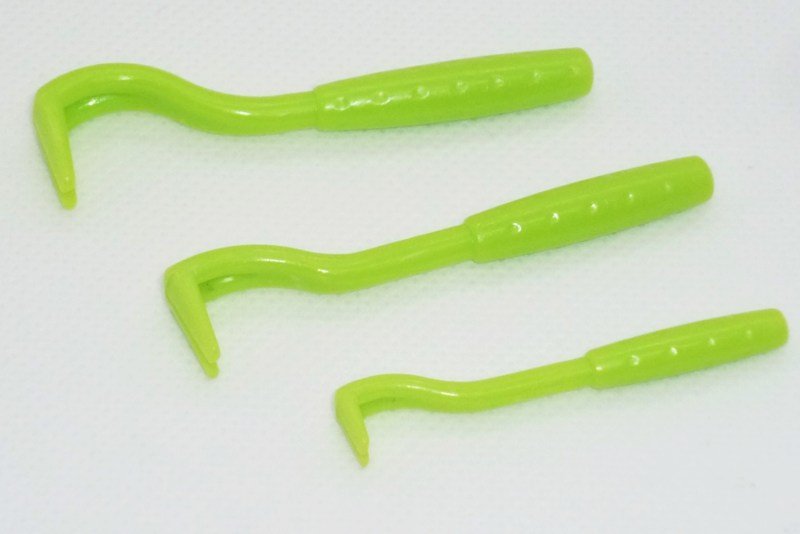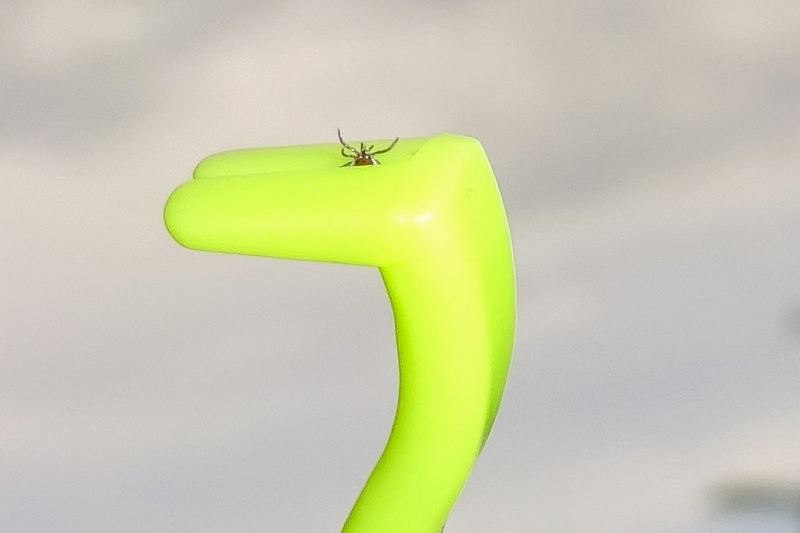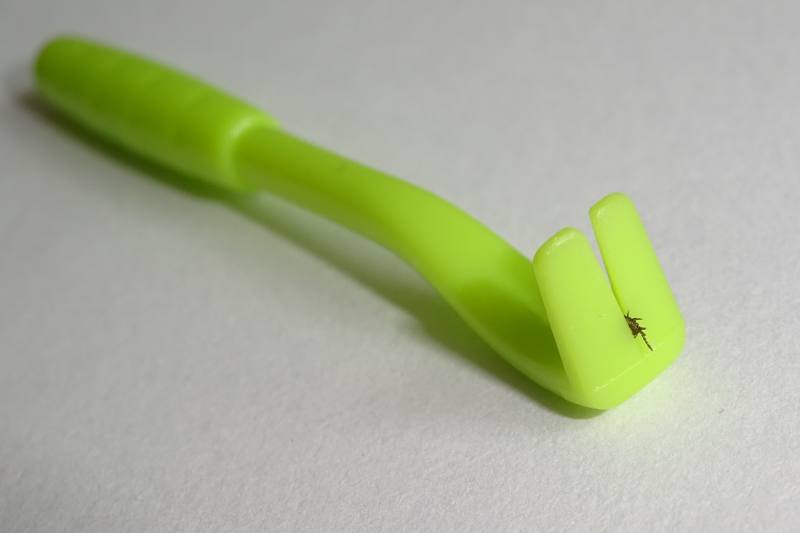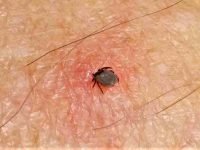A tick hook is a small, practical tool with which ticks can be pulled out of the skin. Tick hooks are available in different sizes, so small nymphs or large ticks can be removed easily.
What is A Tick Hook
A tick hook looks a little bit like a crowbar. And just like a crowbar, this type of tick removal tool consists of a rod with a curved end with flattened tips and a small, narrowing tapering gap in the middle.
This flattened end with the tapering fissure can be pushed carefully around the tick to grab it. Then it can be slowly and carefully pulled out of the skin.
Originally, tick hooks were developed to remove ticks from horses, dogs, and cats. However, they have shown to be quite useful to remove ticks from humans too.
Tick hooks are small and light, they fit into any bag or pocket. They come in different sizes. Use the larger ones for large ticks or ticks that are full of blood. Small hooks have a very fine gap, so even small tick nymphs can be removed with it.

Advantages of a Tick Hook
- Easy and safe to use.
- Comes in different sizes for small ticks or large ticks.
- Unlikely to crush the tick during removal.
- When used as instructed, the risk of tick parts breaking off is low.
- Does not stress tick very much. Less risk that the tick will secrete fluid into the wound due to stress.
- Small, fits in any pocket or backpack
Disadvantages of a Tick Hook
- When the twisting method is used, the mouthparts of the tick may break off. Work very slow.
- Ticks may slip through if a too large tool is chosen, they could get squashed in the process.
- Pet may not keep still long enough. But that problem is there with all tick removal
No products found.
How to use a tick hook
If you want to remove a tick, it is important to remain calm. This ensures that the tick is carefully pulled out of the bite site in one piece. It is also important that the tick does not notice much of the thing so that it does not feel stressed and possibly vomits into the wound and thus still transfers pathogens.
The first question that always arises is: Twist or pull?
A tick hook can be used for both tick removal techniques. You can twist or pull.
However, the question of whether ticks should be pulled out or twisted out is still been debated. Medical professionals, as well as tick remover manufacturers, can also not agree on the best method.
Some believe that twisting works much better, while others promote pulling the tick out. Both methods have advantages and disadvantages.
When twisting, there is a risk of twisting off a part of the tick, which then remains stuck in the skin.
However, even if you pull the tick straight up, there is a risk that part of the tick will be torn off. However, if you pull carefully and evenly, the risk is lower.
I pull the tick out in a very slow and steady motion. Rarely does the mouthpart break off.

Step-by-step instructions
- Select the appropriate size hook. If in doubt, choose the smaller hook.
- Have wound disinfectant-ready (e.g. alcohol pads) to clean the wound after the tick has been removed.
- Disinfect the tick hook.
- Slowly and carefully push the hook under the tick as far as possible.
- With a slow and steady motion, pull the tick out. Or, as some recommend: Twist the hook slowly around while you slightly pull.
- Inspect the tick, to see if it is in one piece. Put the tick into a glass jar and keep it in case its need for analysis.
- Inspect the wound, disinfect it with rubbing alcohol or similar, cover it if necessary.
After a tick bite, you have to monitor yourself and your body signed and symptoms.
If a circular red spot forms after about a week and spreads outwards, you have to see a doctor as soon as possible. This could indicate an infection with borreliosis bacteria.
If you experience weakness or flu-like symptoms (e.g. fever, body aches), you should see your family doctor quickly.
Once you have kept the tick, the doctor can check whether it contains dangerous pathogens (e.g. TBE viruses).
Conclusion
Tick hooks are good and effective tools to remove ticks quickly and easily. They work on people as well as on pets. The advantage over tick pliers and tweezers is the low possibility of accidentally squashing the tick.
Prevention is better than cure
If you are regularly dealing with tick problems, you should look into stepping up preventive measures instead of having to remove ticks often. There are a number of options for this too.
There are a variety of effective tick repellents that you can apply topically to skin and clothing when going into areas where ticks are common. There are also effective repellents for your pets.
Whether you rather use strong synthetic tick repellents or natural repellents that contain essential oils needs considering and taking into account all the advantages and disadvantages and the risk factors given by the environment, like how high the tick risk is.
For your yard and garden, there are also a variety of preventive measures that you can take to decimate the tick population and keep it under control.



